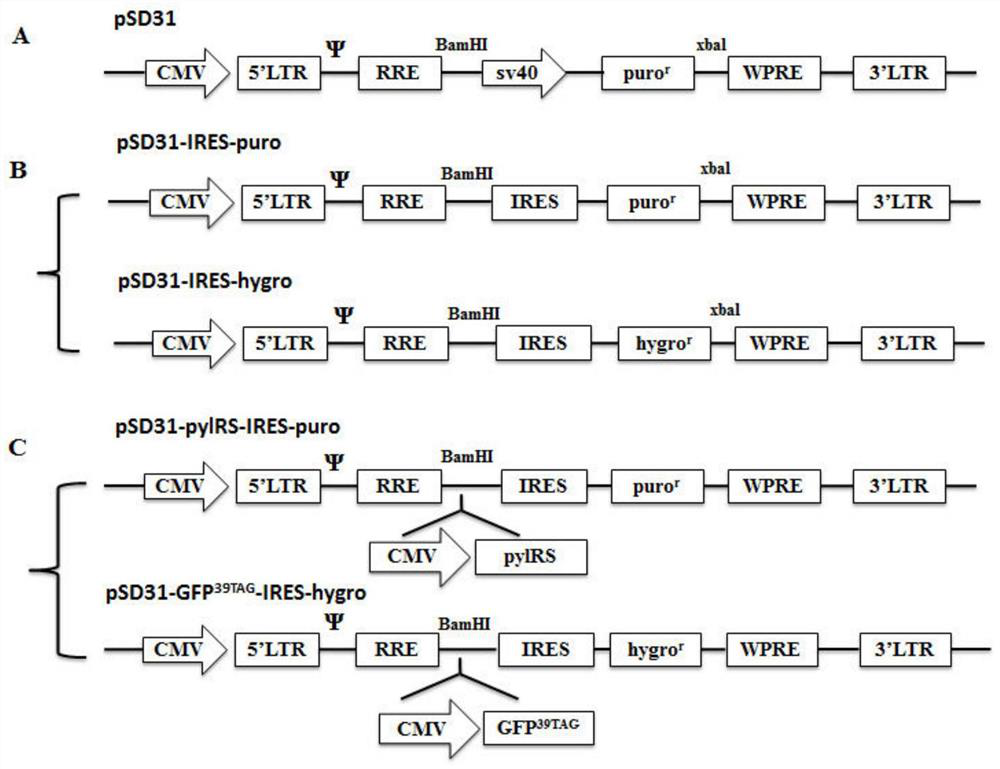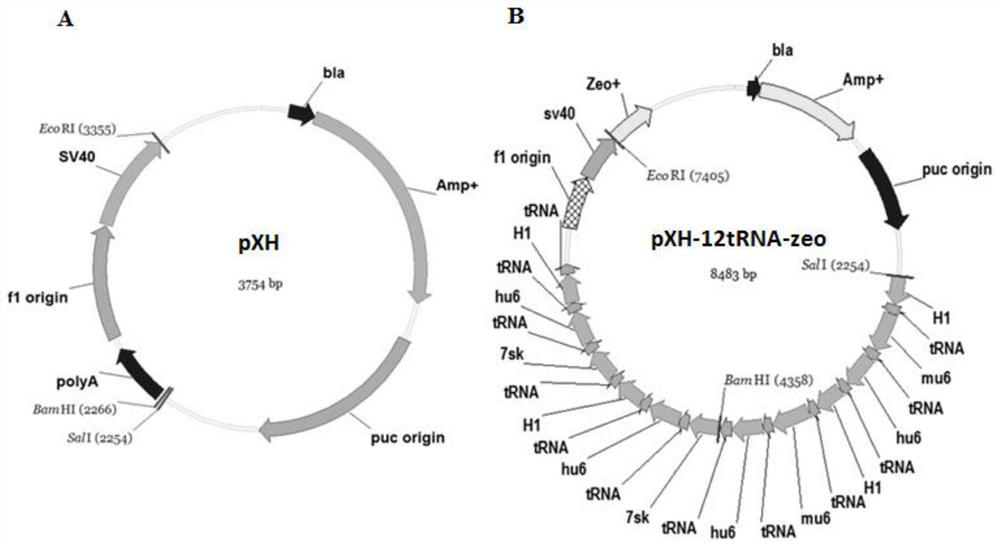Construction of stable cell line carrying orthogonal tRNA/aminoacyl tRNA synthetases
A cell line and synthase technology, applied in the field of biopharmaceuticals, can solve problems such as the bottleneck of industrial application of gene codon expansion technology
- Summary
- Abstract
- Description
- Claims
- Application Information
AI Technical Summary
Problems solved by technology
Method used
Image
Examples
Embodiment 1
[0060] Example 1: Construction and acquisition of double lentiviral vector
[0061] (1) Obtaining the carrier skeleton
[0062] The backbone of the double lentiviral vector is the lentiviral vector pSD31 (Zhang Jing. et al. RNA, 2007, 13:1375–1383.), in which the sv40 promoter promotes the puromycin resistance gene protein puro R expression.
[0063] (2) Primer design for SOE PCR
[0064] The inventors used SOE PCR to splice the DNA fragments of the internal ribosome entry sequence (IRES) and the puromycin (puromycin) resistance gene / hygromycin B (hygromycin) resistance gene to obtain IRES-puro and IRES- hygro fragment, the specific primers are shown in the table below.
[0065] Table 1: List of SOE PCR primers
[0066]
[0067]
[0068] (3) Transformation of lentiviral vector
[0069] On the basis of pSD31, the sv40 promoter and puromycin resistance gene fragments were replaced with IRES-puro and IRES-hygro fragments by double digestion with BamHI and xbal, thereby...
Embodiment 2
[0070] Example 2: Construction and acquisition of pXH-12tRNA-zeo vector
[0071] In order to ensure the expression of tRNA, it is necessary to clone multiple copies of the promoter-tRNA expressed in tandem into an appropriate vector. In the present invention, the pXH blank vector is used as the backbone, and the zeomycin-polyA sequence is introduced into the back of the SV40 promoter through the EcoRI restriction site, so that it has bleomycin resistance. After that, 12 copies of the promoter-tRNA sequence were cloned into the pXH-zeo vector using the SalI restriction site. In order to avoid the possibility of recombination of repeated sequences, 4 different tRNA promoters were used: 7sk / hu6 / H1 / mu6. Finally, the vector bjmu-12t-zeo for screening tRNA was obtained.
[0072] (1) Obtaining the carrier skeleton
[0073] The backbone of the pXH-12tRNA-zeo vector is the vector pXH, which is a shuttle vector transformed from the PUC19 vector, which has the advantages of being abl...
Embodiment 3
[0083] Example 3: Screening of Stable Cell Lines
[0084] (1) Packaging and transduction of lentivirus, including the following steps:
[0085] a.HEK 293T cell plating: using medium A, components (DMEM+10%FBS, 1×NEAA, withoutsodium pyruvate), cell digestion and counting, the number of cells seeded in each well of a six-well plate is 4×10 5 cells / well.
[0086] b. Lentivirus packaging: Transfection is performed at a cell density of 70% to 80%, and the mixture of plasmids and transfection reagents is shown in Table 3-1. Six hours after transfection, medium B (DMEM+3% FBS, 1×NEAA, With Sodium Pyruvate) was changed. Continue to cultivate. The virus liquid was collected 48 hours and 72 hours after transfection, and filtered with a PVDF membrane syringe filter with a pore size of 0.45 μm.
[0087] Table 3-1. Plasmid ratio for lentiviral packaging
[0088] Plasmids / Transfection Reagents Dosage per well Opti-MEM 200μl transfer vector 0.72μg pRSV 0...
PUM
 Login to View More
Login to View More Abstract
Description
Claims
Application Information
 Login to View More
Login to View More - R&D
- Intellectual Property
- Life Sciences
- Materials
- Tech Scout
- Unparalleled Data Quality
- Higher Quality Content
- 60% Fewer Hallucinations
Browse by: Latest US Patents, China's latest patents, Technical Efficacy Thesaurus, Application Domain, Technology Topic, Popular Technical Reports.
© 2025 PatSnap. All rights reserved.Legal|Privacy policy|Modern Slavery Act Transparency Statement|Sitemap|About US| Contact US: help@patsnap.com



